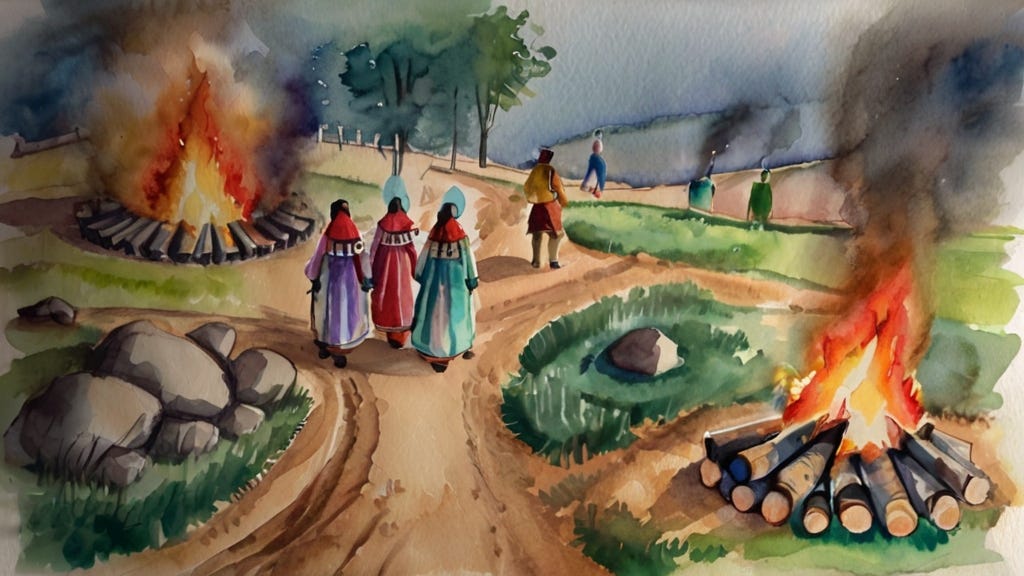In part 1 of this two-parter on belonging, we were getting into moving between circles of belonging.
I attended a class recently with the wonderful artist-teacher-ceremonialist-textile practitioner: Laura Burns. I interviewed her some time ago; dig back and have a listen if you'd like. She spoke about moving between circles of belonging, and gave the example of queer folks who were born in a family who are not welcoming to queerness, especially in their own children. These children experienced a crisis of belonging in their families. Those who stood their grown often found the strength to do so because of finding new belonging with other queer folks. In this other circle of belonging, that part of themselves—that integral part of themselves—was not just tolerated but very welcome.
We can’t live without belonging somewhere. How can we find the strength to disagree and stand for principles in one circle of belonging, unless we find belonging in another circle?
For myself, when I came into seeking spiritually, I didn't find much belonging in my own culture, in secular society or in a church. I found belonging in a spiritual path from another land. When I fell out of that, I found belonging in marriage, and in connection with the lands where I grew up. Now I'm seeking a diversity of belonging, because I'm suspicious of putting too many eggs in one basket, especially baskets of human belonging.
We see this moving between circles in the animal world too. If the mother of a group of ducklings is killed, they may follow another mother. We see it on an international level. When Einstein couldn't stay in Europe at the onset of World War Two, he found some belonging in the United States. When young men from the United States were drafted into the Vietnam War, and they refused to risk their lives for a cause they abhorred, they found belonging across the border in Canada.
I have a great uncle named Walter, back in England, more than a hundred years ago. His father had died and his mother lacked the means take care of him and his sister. She left them in Sherwood Forest (famous for Robin Hood). They were found beneath the trees by passer-by’s, and the call went out, ‘Who will care for these children?’
Someone took Walter, another took his sister. The people who took them in were not biological relations, but relations nonetheless. They raised the children up, and Walter married into my family. Those kids found a kind of belonging, and Walter and I are part of the same extended family, although I'm too young to have met him in the flesh.
In this way, people and animals are sometimes forced to find belonging, unsure of whether they'll find it or not, of whether they'll even survive. But for many of us, we may at least step into another circle of belonging to find some strength so we can turn and make a stand in the circle giving us trouble. Like finding belonging in a queer community to make a stand when coming out with one's family. Or taking a step into a spiritual community to come out as weirdly spiritual with one's colleagues. Or taking a step into an earth-connection group to make a stand with one's ascendant-minded congregation.
Laura Burns also spoke of a mentor of hers, who as a child got bounced around from one foster home to another, and couldn't find anything close to the kind of belonging that she needed. She found it in spirit. A spiritual belonging where she dwelled, in the absence of human belonging. Now, as she grew up, she was able to find and forge connections within fellow humans, but for some time that spiritual belonging was enough to keep her alive.
Human and Spiritual Belonging: A Figure-Eight
Laura Burns suggested that human belonging and spiritual belonging could be conceived of together as a figure eight. Energy moves around this form, with each one feeding into the next.
Human belonging can help spiritual belonging can help human belonging can help spiritual belonging can help human belonging.
When things go sideways in human belonging—because we can be strange and fickle—then there is spiritual belonging. It is more steady, though perhaps more difficult to conceive and understand for our mammalian natures seeking warm skin and food. Spiritual belonging can feel vast and cosmic, or near and intimate. Both are important, and both can feed each other.
Moving Between Vocational Circles
In business, moving between circles could mean stepping into a new field to gradually build up connections, clients, and funds; while keeping one foot in the old arena. For myself, my old arena is working with media— films, podcasts, paintings and such. I'm stepping into helping people think in stories, as I'm doing with this article. I thought I might leave the media work quicker than I have, but I'm realizing that this is a slow step, and that actually there's more connection between these two fields than I had realised. It may not be such a bad thing to keep a foot in both.
Story Prompts
Consider a circle to which you belong, which feels prescient and relevant to you now. This could be family, friends, an interest group, an area of the earth or business that you're involved in.
What do have to offer to this circle?
Of that, what is understood and welcome in the circle and what is not?
Then consider another circle of belonging.
What do have to offer to this circle?
Of that, what is understood and welcome in the circle and what is not?
Consider how you might adjust yourself in relation to this first group, and in relation to this second group, so that you can express all that you want to express, and receive nourishment in kind.
Feel free to share your thoughts in the comments.
Thanks for reading!
Until the next
xxt











